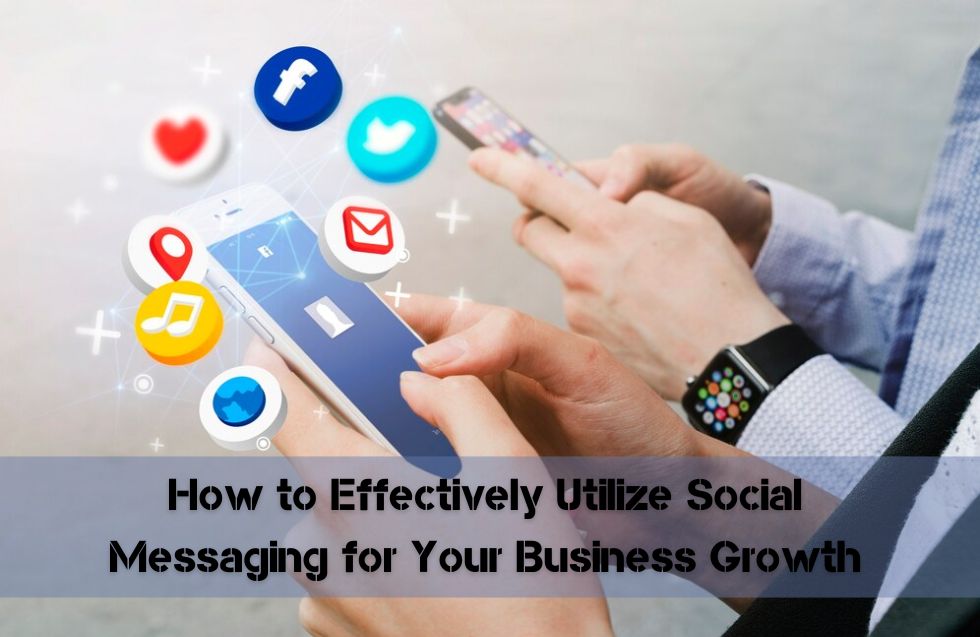In today’s digital age, businesses have access to an array of tools and platforms that enable them to engage with customers more directly and efficiently than ever before. Among these, social messaging platforms stand out as a powerful means of communication. Whether through WhatsApp, Facebook Messenger, WeChat, or Instagram Direct, businesses now have the opportunity to connect with their audience in real time, offering personalized service, timely responses, and meaningful interactions.
With over 3 billion active users on various messaging apps, according to Statista, leveraging social messaging for business growth is no longer optional—it’s essential. However, simply having a presence on these platforms isn’t enough. To truly harness their power, businesses need to develop strategic approaches to how they communicate, engage, and convert their audience into loyal customers.
In this article, we’ll explore how businesses can effectively utilize social messaging for growth, including strategies, key statistics, and real-world examples.
1. Understanding the Power of Social Messaging
Social messaging platforms offer a unique opportunity for businesses to engage with their audience in a personal and conversational manner. Unlike traditional advertising methods or social media posts, messaging allows for one-on-one interaction, which is often more engaging and effective in building customer relationships.
Why Social Messaging is Key for Growth:
- High Engagement Rates: Messaging platforms typically see much higher engagement rates than social media posts. For example, Facebook Messenger boasts an open rate of 80% and a click-through rate of 20%, compared to email’s average open rate of 18%, according to MobileMonkey.
- Real-Time Communication: Customers expect faster responses than ever before, and messaging platforms allow businesses to meet those expectations by providing instant support and information.
- Personalization: Through social messaging, businesses can personalize interactions based on customer preferences, purchase history, and browsing behavior, leading to more meaningful connections and higher conversion rates.
2. Choosing the Right Platforms
Not all messaging platforms are created equal, and different platforms are popular in different regions and demographics. Choosing the right platform for your business is essential to effectively reach your target audience.
Top Messaging Platforms for Business:
- WhatsApp: With over 2 billion monthly active users, WhatsApp is the most widely used messaging app globally. It is particularly popular in Europe, Latin America, and parts of Asia, making it ideal for businesses looking to reach a global audience.
- Facebook Messenger: With 1.3 billion active users, Messenger offers deep integration with Facebook and is popular in North America and Europe. It’s a great platform for businesses already using Facebook for marketing.
- WeChat: With over 1.2 billion monthly active users, WeChat dominates the Chinese market and is essential for businesses targeting Chinese consumers.
- Instagram Direct: For businesses focused on visual content and targeting younger audiences, Instagram Direct offers direct messaging capabilities integrated with Instagram’s social features.
By understanding which platforms your audience prefers, you can tailor your messaging strategy to ensure maximum reach and engagement.
Statistics:
- According to Facebook, over 40 million businesses are active on Messenger, using it to connect with customers.
- WhatsApp Business API reports that over 175 million people send messages to a WhatsApp Business account daily.
3. Key Strategies for Effective Social Messaging
Utilizing social messaging effectively requires more than just being available on these platforms. Businesses need a strategy that aligns with their overall goals, engages their audience, and delivers value through every interaction.
a) Personalized Messaging for Customer Engagement
One of the biggest advantages of social messaging is the ability to personalize communication. Customers appreciate personalized service, and messaging apps make it easy to tailor interactions based on their preferences, purchase history, and previous conversations.
Tips for Personalization:
- Use customer names in messages.
- Reference previous interactions or purchases.
- Offer personalized product recommendations based on browsing behavior or past orders.
b) Automating Responses with Chatbots
Automation plays a critical role in scaling your social messaging strategy, especially for businesses with large customer bases. Chatbots can handle common customer inquiries, provide product recommendations, and even assist in the purchasing process, all while freeing up human agents to handle more complex tasks.
Benefits of Chatbots:
- Instant Responses: Chatbots can provide instant answers to frequently asked questions, improving customer satisfaction and reducing wait times.
- 24/7 Availability: Unlike human agents, chatbots can operate around the clock, ensuring that customers can get the help they need at any time.
- Cost Efficiency: Automating common queries and processes reduces the need for large customer support teams, cutting down on operational costs.
c) Creating a Seamless Shopping Experience
Messaging platforms are increasingly integrating e-commerce functionalities, allowing customers to browse, purchase, and track orders directly within the app. For businesses, this provides a seamless way to convert conversations into sales.
Key Features for Commerce:
- Product Catalogs: WhatsApp and Instagram Direct allow businesses to showcase their products directly within the app, enabling users to browse and ask questions in real-time.
- In-App Payments: Some messaging platforms, like WeChat, offer built-in payment gateways, making it easier for customers to complete purchases without leaving the conversation.
d) Providing Excellent Customer Support
One of the most common uses of social messaging is for customer support. Whether it’s resolving an issue or answering a query, messaging apps allow businesses to provide personalized, real-time support that builds trust and customer loyalty.
Best Practices for Support:
- Use a combination of chatbots and human agents to handle inquiries.
- Set clear response time expectations with automated messages when human agents are unavailable.
- Collect feedback at the end of each conversation to continuously improve service quality.
e) Running Targeted Marketing Campaigns
Messaging apps can also be used to send targeted marketing messages, such as product launches, promotions, or personalized offers. Unlike email or social media, messaging offers a more intimate and direct way to communicate with customers, increasing the likelihood of engagement.
Example:
A retail brand can use WhatsApp to notify loyal customers about an exclusive flash sale, offering a personalized coupon code. Since messages on WhatsApp are likely to be read within minutes, this approach can drive immediate sales.
4. Measuring Success and Optimizing Performance
To ensure that your social messaging strategy is contributing to business growth, it’s essential to track performance and optimize based on data. Here are some key metrics to monitor:
Key Metrics:
- Response Time: How quickly are your team or chatbots responding to customer inquiries? Reducing response time is key to improving customer satisfaction.
- Customer Satisfaction (CSAT): Use surveys or feedback forms to measure customer satisfaction after each interaction. High satisfaction rates indicate that your messaging strategy is effective.
- Engagement Rate: Track how many customers are interacting with your messages, including click-through rates, replies, and shares.
- Conversion Rate: Monitor how many conversations lead to sales, sign-ups, or other desired actions. This metric helps you gauge the effectiveness of your sales and marketing efforts.
Optimization Tips:
- A/B Test Messages: Experiment with different messaging styles, tones, and offers to see what resonates best with your audience.
- Analyze Conversation Flow: Review chat transcripts to identify common issues or friction points in the conversation. Use this data to refine your chatbot’s responses or improve training for human agents.
- Offer Incentives: Encourage more interactions by offering discounts or exclusive offers to customers who engage with your messages.
5. Real-World Success Stories
Many brands have already experienced tremendous success by leveraging social messaging for business growth.
Sephora:
The global beauty retailer uses Facebook Messenger to assist customers with product recommendations and bookings for in-store makeovers. Sephora’s chatbot engages customers with personalized messages, helping them find the right products based on preferences. This approach has increased bookings by 11% and driven higher customer satisfaction.
KLM Royal Dutch Airlines:
KLM uses WhatsApp to provide flight confirmations, boarding passes, and customer service. This strategy has not only improved customer satisfaction but also reduced costs by automating many of the airline’s common customer service inquiries. KLM reports a 35% higher response rate on WhatsApp compared to other customer service channels.
H&M:
The fashion giant uses chatbots on messaging apps to assist customers with styling advice and personalized product suggestions. The chatbot engages users with questions about their style preferences, helping them discover new products and driving higher engagement rates. H&M has seen an increase in sales conversions from customers who use the chatbot.
6. Challenges and Considerations
While social messaging offers immense potential, it’s important to be mindful of certain challenges:
- Privacy Concerns: With stricter data privacy regulations, businesses must ensure that they are compliant with laws such as GDPR. Gaining consent from users before sending promotional messages is crucial.
- Scalability: As your business grows, managing thousands of customer interactions can become overwhelming. Investing in scalable tools like chatbots and CRM systems is essential to maintaining efficiency.
Conclusion
Social messaging offers unparalleled opportunities for businesses to engage with customers, build relationships, and drive growth. By selecting the right platforms, personalizing interactions, and using automation effectively, businesses can unlock the full potential of messaging to enhance customer service, boost sales, and foster brand loyalty.
As the digital landscape continues to evolve, businesses that embrace social messaging will be better positioned to thrive in an increasingly connected world. With the right strategy, your business can leverage social messaging to not only stay competitive but to lead the way in customer engagement and innovation.












